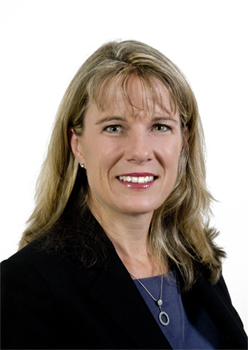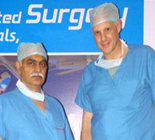The publication is a really important resource for helping Asian hospitals to manage the transformation taking place in the market. Hospitals and other healthcare organisations need access to information about trends and best practices. The magazine is fulfilling an important role. We?d be thrilled to share case studies and put you in contact with some of the organisations that we believe are leading in IT innovation.

Marketing Director Asia Pacific
1. The levels of penetration and adoption of hospital information systems in Asian countries such as Japan, South Korea, Singapore and Australia, compared to countries like the USA, are still in the early stages of adoption. Compared to developed nations, how would you rate IT adoption by hospitals in Asian countries? Which Asian countries do you think are leading the way in this regard?
Over the past 20 years the majority of hospitals have implemented systems to digitize administrative functions including Bookings, Admissions, Discharges and Billing. In the past 10 years there has been a gradual increase in the number of solutions where Clinical functionality is an important component of system selection and second stage implementation.
While many hospitals in the USA were early adopters of healthcare information systems, the size and complexity of this market has created challenges in creating a connected care system across care settings. Other countries, many of which have predominantly publicly-funded care, have made greater progress in building a connected care environment.
Within the region China, Japan, Korea and Malaysia have all made significant progress with the implementation of discrete hospital systems. China has recently initiated a program of work aimed at connectivity, which has the potential to lead to some of the world?s largest connected care environments. But at the moment, the regional leader without a doubt is Singapore. This vibrant but small market has used technology to integrate many information systems and provides a good example of how Asian countries can emulate or supersede progress in the USA.
2. What are the new technologies that are likely to shape the future of healthcare in Asia?
The challenge healthcare organizations face is to intelligently aggregate and unlock patient data across systems to enable new connected care solutions that drive informed actions that improve patient outcomes and operational efficiency. Our vision with InterSystems HealthShare, a strategic informatics platform, is to provide the next generation of advanced functionality to add value to connected care and enable providers to make more meaningful use of patient information.
We believe that modern devices such as tablets and smart phones which doctors, nurses and other clinicians use in their everyday social environment are rapidly becoming a technology of choice in the work place. These devices enable real-time access to valuable information from any point of care.
It is the combination of these devices with software such as HealthShare that is driving innovative change in business processes.
3. What must today’s HIS system being able to do? If you look at developments in the HIS market over the last few years, requirements have risen dramatically. What is your perception of this?
We agree that HIS requirements have risen dramatically over the last few years. The scope of solutions which started in administration has continually expanded into clinical areas that embrace diagnostic services, medication, surgical interventions and clinical consultations. Not only has the functional scope increased but the demand for device integration has grown significantly. These combined factors have led to a massive increase of the volume of digitised information for each and every patient.
As the volume of information increased, a trend for integration rather than solution replacement emerged. These market trends influenced our strategic product planning and led InterSystems to design and develop HealthShare because we recognized that our customers, and the market, would ultimately make the step to acquire a new type of solution that could leverage all of this data to drive intelligent action.
Organizations are recognising that deployment of even the most sophisticated EHR application is only the first step and that we are now entering the post-EHR reality. HealthShare now provides technologies essential to moving far beyond simply capturing and sharing healthcare information. It is a strategic informatics platform that enables understanding, analysing and acting on 100 percent of each patient?s data, so that clinicians will no longer be forced to make treatment decisions with anything less than the entirety of a patient?s record.
4. As InterSystems continues to grow, with products like Caché, TrakCare and now HealthShare, which areas did you focus on while developing the new product? Can end users contact InterSystems Support directly for any problems, at any time?
InterSystems? product development is focused on understanding the evolving needs of healthcare organisations and delivering technology that drives the right action to enable breakthroughs in care and operational performance. In developing the next generation of HealthShare, InterSystems focussed on two key areas – Knowledge Delivery and Active Analytics.
With Knowledge Delivery, HealthShare now includes patented InterSystems iKnow technology that makes it possible to retrieve and utilize unstructured healthcare data. iKnow technology can automatically discover the concepts within text, without the need for a pre-defined dictionary or other difficult or costly set-up. HealthShare?s Active Analytics suite automatically analyzes documents and text, finds and unlocks
the relevant relationships, and allows the user to quickly navigate to relevant content. As a result, clinicians can much more efficiently identify vital information from the growing plethora of data.
HealthShare’s Active Analytics technology provides access to up-to-the-minute patient data to drive informed decisions that can improve outcomes. Using its built-in patient-centric data model, this HealthShare component continuously collects, aggregates, normalizes, and presents data from organizations throughout the care community. Active Analytics can deliver notifications to caregivers or launch clinical or operational processes based on rules invoked from a previous analysis. Featuring powerful data modelling, intuitive tools for designing pivot tables, graphs and charts, and sophisticated workbench design capabilities, HealthShare’s Active Analytics uncovers the missed opportunities associated with purely historical analysis, without the high cost of creating and maintaining a data warehouse.
Addressing the second part of your question, InterSystems is committed to giving our clients the very best customer service possible. Customers of InterSystems can contact us directly to resolve problems at any time. The InterSystems Worldwide Response Centre provides expert technical assistance to our customers 24 hours a day, every day. With personnel based in cities around the globe, the Worldwide Response Centre provides expert, multilingual, 24 x 7 support for InterSystems technology products. The professional Application Developers and Systems Engineers who staff the Worldwide Response Centre are dedicated to the philosophy: “The Customer Sets the Standard.” This means that customers have control over issue priority and closure, and are asked to give feedback about the quality of support they receive.
5. With regard to business models, business standards and the fair evaluation of investments, there is always the concern that certain technologies are a dead end. How future-proof is the HealthShare strategic informatics platform?
Firstly, as a comprehensive platform, HealthShare enables rapid development of sophisticated new solutions and eliminates the costs and complexities that are inevitable with “bolt-on” technology stack solutions. So it is designed from the start to be easy to maintain and to keep ahead of the technology curve.
Secondly, HealthShare provides both interoperability and active analytics. The focus on interoperability means that customers can use HealthShare to connect multiple HIS systems together with a single interface to each one. This makes it much easier to maintain a shared electronic health record and it also protects customers from investing too much time and effort in dead-end systems.
In addition, with HealthShare providing a high-level platform that sits over the top of HIS systems, it is relatively easy to migrate from one system to another. So it helps customers to future proof their healthcare systems and protect themselves from the risk of systems becoming obsolete.
6. How do you keep ahead of the curve when it comes to competitors?
One of InterSystems? key differentiators is that we offer a range of software solutions for connecting care at all levels. Many of your readers would know our TrakCare healthcare information system, providing comprehensive clinical, administrative, and departmental capabilities. But we?re also addressing the gaps that healthcare organizations face in capturing, sharing, understanding and immediately acting upon 100% of their data with HealthShare. Caché is the world?s leading database in clinical applications. We are a trusted brand in healthcare and we continue to bring out new technology to enable smarter care delivery.
Until recently, there has been no such thing as a strategic health informatics platform, so it has been normal for healthcare organisations to use multiple healthcare applications. Which means it has been very difficult to act on 100% of a patient?s data.
Even having a single EHR – which some healthcare organisations have been able to achieve – does not completely solve this problem. The majority of clinical information is typically in the form of unstructured data – such as dictated notes, images and free text – and inaccessible. Finally, you need to have the ability to not only aggregate this information, but also to analyze it and act upon it without imposing the additional overhead, complexity and risk of a separate data warehouse.
Different components of HealthShare address all of these issues or “gaps” in a single strategic health informatics platform. This is not something we believe that our competitors have addressed as successfully, and that gives InterSystems a competitive edge.
7. As a manufacturer, what could you change in a HIS so that you stand out from your competitors and motivate users to switch? What reasons would you consider today for replacing a HIS?
We?ve already talked a lot about the advanced healthcare technologies that make InterSystems stand out from the crowd. But there are some other very important factors that motivate healthcare organisations to choose a supplier and that includes our global experience, the way that we partner with our customers around the world, and our approach to the implementation of new systems.
InterSystems is involved in national connected care projects in Scotland, Sweden, Denmark and Chile, for example. We are also delivering state wide or regional projects in a number of geographies including the Asia Pacific region.
The driving factor in HIS replacement has already shifted from a functional „wish list? to a clinical and business need for a strategic information platform.
When it comes to our implementation approach, we believe that realizing increased value from electronic health records and the building of the enabling infrastructure should go hand in hand. Otherwise you have a situation where you can make huge investments in healthcare IT without quickly realizing any benefits. And this is when you run the risk of major healthcare IT projects going off the rails – it is the exact opposite of the rapid iterative approach that we take to software development which has made InterSystems successful in EHR projects around the world.
8. What challenges does IT adoption bring with it, especially for countries with relatively less degree of IT adoption?
The level of adoption within any country is less significant than the need for h4 leadership in every project. The projects that succeed are always driven by leaders on both sides of the fence, the hospital and the supplier. Whilst the introduction of new healthcare information systems provides opportunities and challenges in day-to-day processes and activities, the biggest challenge of all is to identify, select and retain leadership throughout the project.
Clinical adoption is of particular importance because the largest benefits occur at the point of care and we are investing considerable resources into this area of our deployment methodology.
9. Finally, take a look into the future: What will the HIS of the future look like, and what developments do you expect in terms of manufacturers? Any other issues you would like to comment up on?
When I close my eyes and think of the HIS of the future, I can ignore all of the obstacles and challenges that stand between the hospital of today and the one of the future. I imagine a working environment where carers and patients use information in a touch screen graphical environment through every step of the patient journey. When the patient leaves the hospital that journey leaves with them. The journey is captured in a picture album that?s accessible to the patient, their physician or their carer as and when they choose. The future system has therefore eliminated a significant proportion of duplication and the risk of adverse events.
I expect manufacturers to continually advance device technology to enable the realization of this vision.
10. ‘Asian Hospitals and Healthcare Management’, a leading Healthcare title in print and digital versions, reaches directly to key industry professionals and decision makers in the Healthcare industry. The magazine addresses the most significant developments, trends and features opinions and analyses by respected leaders from the Hospitals & Healthcare industry. What do you think about our magazine which is promoting and branding the healthcare industry today on such a wide scale?
The publication is a really important resource for helping Asian hospitals to manage the transformation taking place in the market. Hospitals and other healthcare organisations need access to information about trends and best practices. The magazine is fulfilling an important role. We?d be thrilled to share case studies and put you in contact with some of the organisations that we believe are leading in IT innovation.




